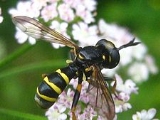
Conops flavipes
Encyclopedia
Conops flavipes is a species
of fly
from the genus Conops
in the family
Conopidae
. Their larva
e are endoparasites
of bumble bees of the genus Bombus. It is common throughout much of Europe
.
Species
In biology, a species is one of the basic units of biological classification and a taxonomic rank. A species is often defined as a group of organisms capable of interbreeding and producing fertile offspring. While in many cases this definition is adequate, more precise or differing measures are...
of fly
Fly
True flies are insects of the order Diptera . They possess a pair of wings on the mesothorax and a pair of halteres, derived from the hind wings, on the metathorax...
from the genus Conops
Conops
Conops is a genus of fly from the family Conopidae. The larvae of Conops are parasitic on bees, especially bumblebees. Adults feed on nectar.-Species:*Subgenus Conops Linnaeus, 1761*C. ceriaeformis Meigen, 1824...
in the family
Family (biology)
In biological classification, family is* a taxonomic rank. Other well-known ranks are life, domain, kingdom, phylum, class, order, genus, and species, with family fitting between order and genus. As for the other well-known ranks, there is the option of an immediately lower rank, indicated by the...
Conopidae
Conopidae
Conopidae, usually known as the thick-headed flies, is a family of flies within the Brachycera suborder of Diptera. Flies of the family Conopidae are distributed worldwide except for the poles and many of the Pacific islands. About 800 species in 47 genera are described worldwide, approximately 70...
. Their larva
Larva
A larva is a distinct juvenile form many animals undergo before metamorphosis into adults. Animals with indirect development such as insects, amphibians, or cnidarians typically have a larval phase of their life cycle...
e are endoparasites
Parasitism
Parasitism is a type of symbiotic relationship between organisms of different species where one organism, the parasite, benefits at the expense of the other, the host. Traditionally parasite referred to organisms with lifestages that needed more than one host . These are now called macroparasites...
of bumble bees of the genus Bombus. It is common throughout much of Europe
Europe
Europe is, by convention, one of the world's seven continents. Comprising the westernmost peninsula of Eurasia, Europe is generally 'divided' from Asia to its east by the watershed divides of the Ural and Caucasus Mountains, the Ural River, the Caspian and Black Seas, and the waterways connecting...
.

